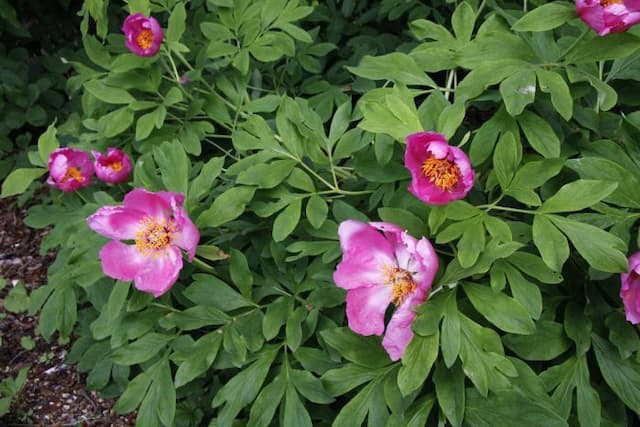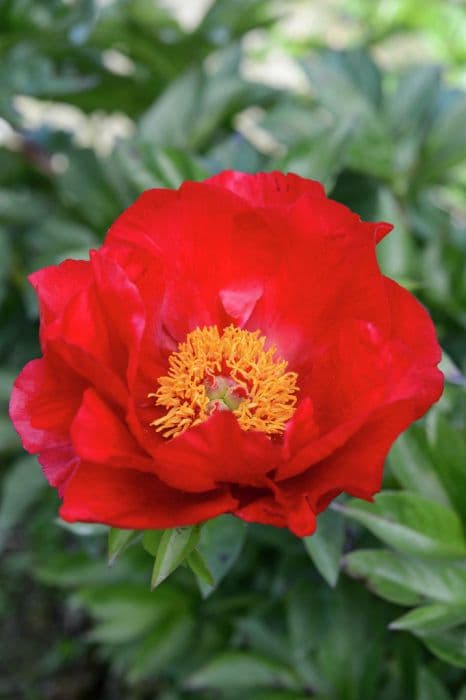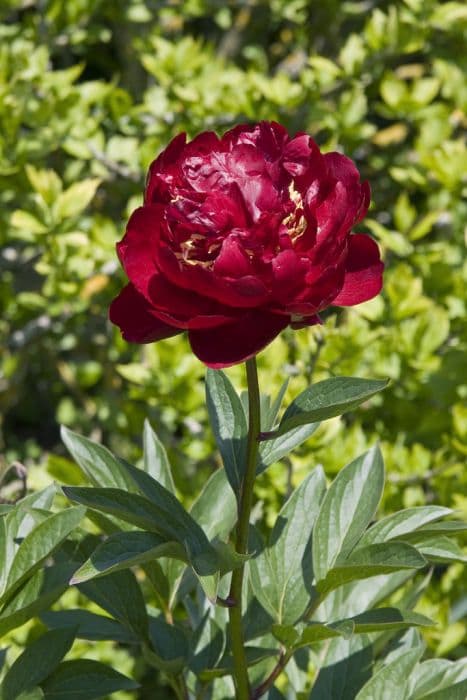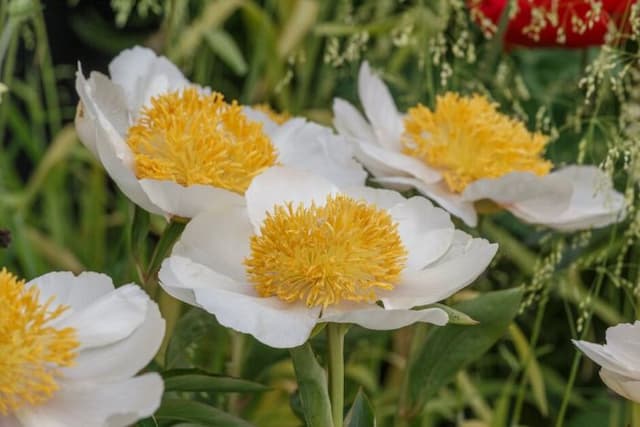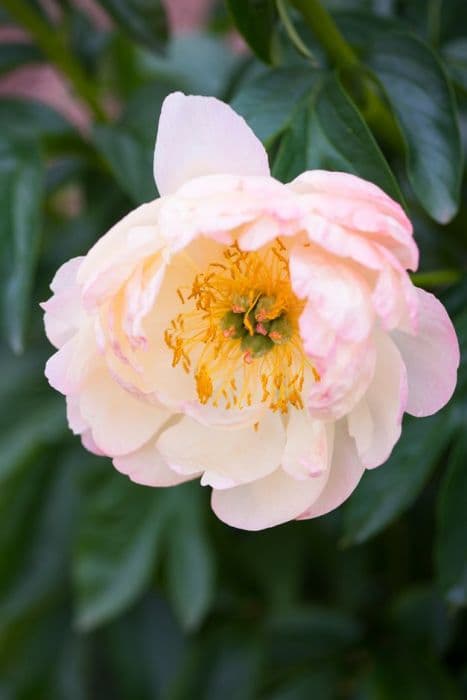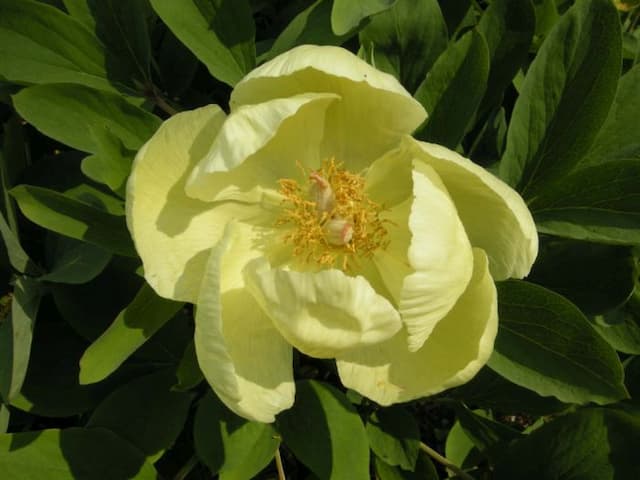Peony Paeonia lactiflora 'Inspecteur Lavergne'

ABOUT
The Paeonia lactiflora 'Inspecteur Lavergne', commonly known as the peony, is admired for its large, showy blooms that make a bold statement in any garden. Each flower is full and rounded, often exhibiting a classic double form with many layers of petals. The petals radiate outward from a dense center, showcasing a rich, velvety red hue that stands out brilliantly against the plant's lush green foliage. At the heart of the flower, one can sometimes catch a glimpse of contrasting golden-yellow stamens, which add an extra touch of elegance to the already stunning blossom. The leaves of the peony 'Inspecteur Lavergne' are an attractive deep green, with a glossy surface and a leathery texture, providing a perfect backdrop for the luxurious flowers. They are typically divided into leaflets, which have a somewhat lance-shaped appearance, and they're neatly arranged in a symmetrical fashion along stiff, upright stems that are sturdy enough to support the heavy blooms. The overall impression of the peony 'Inspecteur Lavergne' is one of lush abundance and classic beauty, evoking a sense of romance and old-world charm in the springtime garden.
About this plant
 Names
NamesFamily
Paeoniaceae
Synonyms
Chinese Peony, Common Garden Peony
Common names
Paeonia lactiflora 'Inspecteur Lavergne'.
 Toxicity
ToxicityTo humans
Peonies, including Paeonia lactiflora 'Inspecteur Lavergne' are generally not considered poisonous to humans. However, peonies contain a compound called paeonol, which can cause mild gastrointestinal upset if ingested in large quantities. Skin contact with the sap of the plant can sometimes result in irritation in sensitive individuals. Ingesting any part of the plant may lead to symptoms such as nausea, diarrhea, and vomiting, although significant toxicity is rare.
To pets
Peonies, including Paeonia lactiflora 'Inspecteur Lavergne', are considered mildly toxic to pets, such as cats and dogs. If ingested, peonies can cause gastrointestinal upset in animals, resulting in symptoms such as vomiting and diarrhea. In most cases, the toxicity is considered to be mild, but if a pet consumes a large amount of the plant, a visit to the vet might be necessary to manage the symptoms.
 Characteristics
CharacteristicsLife cycle
Perennials
Foliage type
Deciduous
Color of leaves
Green
Flower color
Red
Height
2-3 feet (60-90 cm)
Spread
2-3 feet (60-90 cm)
Plant type
Herb
Hardiness zones
3-8
Native area
Asia
Benefits
 General Benefits
General Benefits- Aesthetic appeal: Paeonia lactiflora 'Inspecteur Lavergne', commonly known as peony, adds visual interest to gardens with its large, showy blooms.
- Longevity: Peonies have a notable lifespan, often living for decades and becoming a long-term feature in a garden.
- Seasonal interest: Peonies provide a burst of color in late spring to early summer, bridging the gap between spring bulbs and summer perennials.
- Cut flowers: Blooms from the peony make excellent cut flowers with a long vase life, perfect for indoor decoration.
- Attracts Pollinators: The flowers are known to attract bees and other beneficial pollinators to the garden, promoting plant health and biodiversity.
- Cold hardiness: As a hardy perennial, peonies can withstand cold winter climates, making them suitable for many temperate gardens.
- Low maintenance: Once established, peonies require minimal care beyond annual pruning and occasional feeding.
- Variety of uses: Beyond being a garden plant, peonies are often used in special occasions and floral arrangements, including weddings and events.
- Symbolic meaning: Peonies carry various symbolic meanings such as prosperity, good fortune, and a happy marriage, making them a meaningful addition to a garden.
 Medical Properties
Medical Properties- Anti-inflammatory: Paeonia lactiflora, commonly known as the Chinese peony, traditionally possesses compounds that are believed to reduce inflammation.
- Analgesic: It has been utilized in herbal medicine to alleviate pain.
- Immunomodulatory: There are suggestions that it may have effects on the immune system, potentially modulating immune response.
- Antispasmodic: The plant is also credited with reducing muscular spasms.
- Antioxidant: Chinese peony is thought to have antioxidant properties that may help in protecting the body from oxidative stress.
 Air-purifying Qualities
Air-purifying QualitiesThis plant is not specifically known for air purifying qualities.
 Other Uses
Other Uses- The petals of the peony 'Inspecteur Lavergne' can be used to create natural dyes for fabrics, giving a soft pink hue that is derived from the color of the flower petals.
- These peonies can be pressed to create botanical art, as their large, full flowers maintain color and shape well when dried between sheets of paper.
- When in bloom, peonies can serve as a natural indicator of the spring season, often used in festivals and celebrations to denote the change in seasons.
- The large, lush blooms can be used as a natural, biodegradable confetti at weddings or other celebratory events.
- Peony petals, due to their gentle fragrance, can be infused into sugar to create a subtly flavored sweetener for teas and pastries.
- The plants can be integrated into educational programs about horticulture and botany, highlighting the growth cycle and care of perennials.
- As a photographer's subject, peony 'Inspecteur Lavergne' offers a vibrant and detailed subject matter for botanical photography shoots.
- The sturdy stems and foliage of the plant can be used in composting, contributing to a nutrient-rich compost for garden beds.
- At the end of the blooming season, dried peony seed pods can be utilized in floral arrangements, adding an interesting texture and shape.
- Peony 'Inspecteur Lavergne' can be grown as part of a butterfly garden to attract and support the local butterfly population, as it provides a source of nectar.
Interesting Facts
 Feng Shui
Feng ShuiThe Peony is often used in Feng Shui as a symbol of romance and prosperity, and it is believed to promote love and enhance relationship luck. It may be placed in the southwest corner of a garden or home to attract these energies.
 Zodiac Sign Compitability
Zodiac Sign CompitabilityThe Peony is not used in astrology practice.
 Plant Symbolism
Plant Symbolism- Prosperity: Peony is often associated with wealth and honor, which makes it a popular choice for celebrations and gifting to convey wishes of prosperity.
- Romance: With its lush, full, rounded blooms, the peony is often regarded as a symbol of romance and romantic love. It is also traditionally used in wedding bouquets and decorations.
- Beauty: The peony's attractive and fragrant flowers are symbolic of beauty in all forms, often representing an ideal of feminine beauty.
- Bashfulness: In Victorian times, the peony was used to convey bashfulness or shyness, due to the notion of nymphs hiding in its petals.
- Honor: Peonies exemplify honor and high esteem, often used to acknowledge someone's integrity or to honor people for their achievements.
- Compassion: The lush nature of the flower exemplifies comfort and compassion, making it an appropriate gift during times of healing.
- Good fortune: In numerous cultures, the peony is believed to bring good luck and a happy life, which is why it's often seen in celebratory events such as weddings and new business openings.
 Water
WaterThe common peony, specifically Paeonia lactiflora 'Inspecteur Lavergne', should be watered deeply once a week, ensuring that the soil is moistened through to the root zone. During the growing season, it may require more frequent watering, especially if there are extended periods of dry weather. It's vital to avoid overwatering as peonies do not like to sit in waterlogged soil. A good practice is to provide about an inch of water, which typically amounts to about 0.6 gallons per square yard of soil, depending on soil type and weather conditions. During the dormant season in fall and winter, watering should be reduced.
 Light
LightPeonies like Paeonia lactiflora 'Inspecteur Lavergne' thrive in a sunny spot that receives at least six hours of direct sunlight a day. However, in regions with very hot summers, they benefit from light afternoon shade to prevent overheating. A location that offers morning sunlight with some protection from the harsh afternoon sun is ideal for this plant.
 Temperature
TemperaturePaeonia lactiflora 'Inspecteur Lavergne', the common peony, prefers a temperate climate with cold winters, as they require a chilling period to bloom successfully. They can survive winter temperatures down to about -20°F and enjoy a growing season with temperatures ranging between 65°F and 75°F. Peonies are robust and can tolerate summer heat up to around 85°F without stress.
 Pruning
PruningThe common peony, such as Paeonia lactiflora 'Inspecteur Lavergne', should be pruned to remove spent flowers after blooming to maintain a tidy appearance and to prevent seed development, which can draw energy away from the plant. In the fall, after the leaves have died back, prune the stems down to about 3 inches above ground level to help prevent overwintering diseases. Annual pruning in this manner will also help promote vigorous growth in the following season.
 Cleaning
CleaningAs needed
 Soil
SoilThe best soil mix for Chinese Peony (Paeonia lactiflora 'Inspecteur Lavergne') is well-drained, fertile, and rich in organic matter. A mix of two parts loam, one part peat moss or well-rotted compost, and one part sand or perlite can provide the necessary drainage and nutrients. Soil pH should be neutral to slightly alkaline, between 6.5 and 7.5.
 Repotting
RepottingChinese Peony typically does not need frequent repotting as they prefer to be left undisturbed. Repotting can be done every 3-5 years or when the plant shows signs of becoming root-bound or growth appears to be slowing.
 Humidity & Misting
Humidity & MistingChinese Peony thrives in average humidity conditions. They do not require high humidity and will do well with the natural outdoor humidity in most temperate climates. Therefore, specialized humidity control is generally unnecessary for this plant.
 Suitable locations
Suitable locationsIndoor
Provide bright light, cool temps, and keep the soil lightly moist.
Outdoor
Plant in full sun, enriched well-draining soil, mulch in winter.
Hardiness zone
3-8 USDA
 Life cycle
Life cyclePaeonia lactiflora 'Inspecteur Lavergne', commonly known as Chinese peony, starts its life cycle as a dormant tuber planted in well-drained soil during the fall. In spring, the tuber sprouts and produces glossy, green leaves on strong stems, followed by the development of large, fragrant flowers that bloom in late spring to early summer. After flowering, the plant sets seed in the form of a capsule, which when mature, splits open to disperse seeds. The foliage continues to grow throughout the summer, providing photosynthetic energy that is stored in the tuberous roots. As autumn arrives, the foliage yellows and dies back, with the plant entering a period of dormancy throughout the winter months. The cycle begins anew the following spring when temperatures warm, completing a perennial growth habit.
 Propogation
PropogationPropogation time
Late winter
The Paeonia lactiflora 'Inspecteur Lavergne', more commonly known as the Chinese peony, is best propagated through division of its root system. The ideal time for propagating Chinese peonies by division is in the fall after the plants have flowered and as they begin to die back. During this time, the plant is entering dormancy and experiences less stress during the division process. To propagate by division, carefully dig up the peony plant, maintaining as much of the root system as possible. Clean the soil from the roots and use a sharp knife to cut the root ball into sections, ensuring that each section has at least three to five eyes, or growth buds. These sections can then be replanted in well-drained soil at a depth of about 1.5 to 2 inches (3.8 to 5.1 centimeters), with the eyes facing upwards, and spaced about 3 feet (approximately 0.9 meters) apart to allow for growth. Water the newly planted divisions thoroughly to help establish them.
